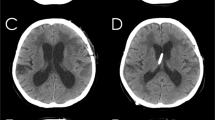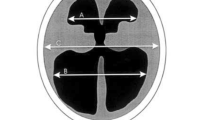Summary
The efficacy of shunting the hydrocephalic edema was evaluated by means of transmission electromicroscopical observation (TEM) comparing ultrastructual alterations seen in either valid or invalid shunted feline hydrocephalus. Owning to shunt placement, deteriorated clinical symptoms recovered and one of the observed morphological alterations such as gliosis developed chronologically after the initiation of hydrocephalus. On the other hand, so called hydrocephalic edema observed in the region of periependymal tissue after shunt placement was improved not only in both valid and invalid shunted but also even in sham group however the extent of these alterations were different from each other. Among such observation, a distinct chronological linkage between the morphological alterations and clinical outcome was not noted. Our conclusions in present study were 1) shunt implantation results in the promotion of gliosis in the region of periventricular tissue in spite of the expected efficacy of shunt, 2) recovery of hydrocephalie edema was influenced not only by effective shunt implantation but also by the processes in chronological tissue reconstructions occurred in the natural course of hydrocephalus, and 3) early treatment of periventricular edema in hydrocephalus through shunting corrects the illfated neuro axis environments and reforming the intracranial conditions such as normalizing ICP and relieving hemodynamic distress seems to be more important than morphological recovery in treating hydrocephalus.
Access this chapter
Tax calculation will be finalised at checkout
Purchases are for personal use only
Preview
Unable to display preview. Download preview PDF.
Similar content being viewed by others
References
Del Bigio MR, Bruni JE (1988) Changes in periventricular vasculature of rabbit brain following induction of hydrocephalus and after shunting. J Neurosurg 69: 115–120
Fried A, Shapiro K, Takei F, Kohn I (1987) A laboratory model of shunt dependent hydrocephalus. Development and biomechanical characterization. J Neurosurg 66: 734–740
Ingraham FD, Matson DD, Alexander E Jr (1948) Studies in the treatment of experimental hydrocephalus. J Neuropathol Exp Neurol 7: 123
Nulsen FF, Spitz EB (1952) Treatment of hydrocephalus by direct shunt from ventricle to jugular vein. Surg Forum 2: 399
Oi S, Matsumoto S (1986) Morphological findings of postshunt slit ventricle syndrome in experimental canine hydrocephalus. A aspect of causative factors of isolated ventricles and slit ventricle syndrome. Nerv Syst Child 2: 179–184
Rubin RC, Hochwald GM, Tiell M, et al (1976) Hydrocephalus: III Reconstitution of the cerebral cortical mantle following ventricular shunting. Surg Neurol 5: 179–183
Sato O, Ohya M, Nojiri K, Tsugane R (1984) Microcirculatory changes in experimental hydrocephalus: morphological and physiological studies. In: Shapiro K, Marmarou A, Portnoy H (eds) Hydrocephalus. Raven, New York, pp 215–230
Shapiro K, Takei F, Fried A, Kohn I (1985) Experimental feline hydro-cephalus. The role of biomechanical changes in ventricular enlargement in cats. J Neurosurgery 63: 82–87
Shapiro K, Fried A (1986) Pressure-volume relationship in shunt-dependent childhood hydrocephalus. The zero of pressure instability in children with acute deterioration. J Neurosurg 64: 390–396
Takei F, Shapiro K, Hirano A, Kohn I (1987) Influence of the rate of ventri enlargement on the ultrastructual morphology of the white matter in experimental hydrocephalus. Neurosurgery 21:645–650
Takei F, Shapiro K, Kohn I (1987) Influence of the ventricular enlargement on the white matter water content in progressive feline hydrocephalus. J Neurosurgery 66: 577–583
Author information
Authors and Affiliations
Editor information
Editors and Affiliations
Rights and permissions
Copyright information
© 1994 Springer-Verlag
About this paper
Cite this paper
Takei, F., Shapiro, K., Oi, S., Sato, O. (1994). The Efficacy of Shunting the Hydrocephalic Edema. In: Ito, U., et al. Brain Edema IX. Acta Neurochirurgica, vol 60. Springer, Vienna. https://doi.org/10.1007/978-3-7091-9334-1_160
Download citation
DOI: https://doi.org/10.1007/978-3-7091-9334-1_160
Publisher Name: Springer, Vienna
Print ISBN: 978-3-7091-9336-5
Online ISBN: 978-3-7091-9334-1
eBook Packages: Springer Book Archive




